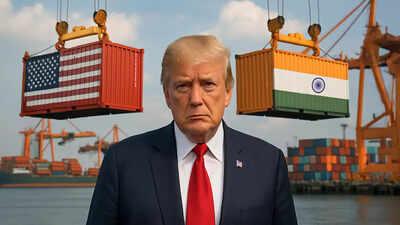In a significant escalation of trade tensions, former President Donald Trump has followed through on his threat to impose a 50% tariff on imports from India. The move marks a dramatic shift in the economic relationship between the two countries, raising concerns over potential impacts on global markets and bilateral trade. This decision, announced earlier this year, comes amid ongoing disputes over trade imbalances and market access, signaling a tougher stance from the Trump administration on foreign trade policies.
Trump Enforces 50 Percent Tariffs on Indian Goods Impacting Trade Relations
In a significant escalation of trade tensions, the Trump administration has officially imposed a 50 percent tariff on a wide array of goods imported from India. This move follows months of negotiations that failed to resolve concerns over trade imbalances and market access. Industries most affected include textiles, pharmaceuticals, and information technology hardware, sectors where India holds a competitive advantage. The tariffs are expected to disrupt supply chains and increase costs for U.S. businesses reliant on Indian imports, with broader implications for the bilateral economic relationship.
Indian exporters and trade officials have expressed dismay, warning that the tariffs could lead to retaliatory measures and potentially trigger a trade war. The U.S. administration justifies the tariffs by citing unfair trade practices and intellectual property issues. Below is a snapshot of the initial sectors impacted and estimated share of Indian exports to the U.S. for each category:
| Sector | Estimated Export Share | Tariff Impact |
|---|---|---|
| Textiles & Apparel | 28% | Significant price hikes, supply chain shifts |
| Pharmaceuticals | 22% | Higher costs, potential drug shortages |
| Information Tech Hardware | 18% | Increased component prices, investment concerns |
| Other Consumer Goods | 32% | Market contraction, competitive displacement |
- Indian government response: Accelerated talks with global trade bodies to challenge tariffs
- Business communities: Calls for dialogue and resolution to prevent escalation
- Market outlook: Short-term uncertainty with possible long-term shifts in trade partners
Economic Implications for US and Indian Markets Explored
The imposition of a 50% tariff on imports from India marks a significant shift with wide-reaching consequences for both the US and Indian markets. For the US, consumers could face steep price increases on products ranging from textiles to electronics, potentially dampening consumer spending and inflation dynamics. American businesses dependent on Indian supply chains may need to pivot sourcing strategies, incurring higher operational costs in the short term. On the flip side, certain US domestic industries, particularly steel and aluminum manufacturers, might experience a competitive revitalization due to reduced import competition.
- Impact on Indian exporters: Reduced market access and profit margins could curtail growth, especially in key sectors like pharmaceuticals and IT hardware.
- Consumer prices in the US: Inflationary pressures expected to rise due to elevated costs of imported goods.
- Supply chain disruptions: Companies may seek alternative partners, triggering shifts in global trade patterns.
| Market | Short-Term Impact | Long-Term Outlook |
|---|---|---|
| US | Price hikes, supply chain adjustments | Potential industry reshoring, inflation risks |
| India | Export decline, GDP growth slowdown | Market diversification, push for self-reliance |
For India, the tariffs present a formidable challenge to sustaining export growth, which is pivotal for the country’s economic momentum and job creation. The move may accelerate government efforts toward “Make in India” and self-reliance initiatives, fostering stronger domestic manufacturing capabilities. Yet, industries heavily reliant on the US market might witness profitability downturns and a strategic reorientation toward other international markets. Politically, this tension underscores the need for renewed bilateral dialogue to mitigate further economic fallout.
Industry Reactions and Potential Shifts in Global Supply Chains
Global market leaders and trade experts have responded swiftly to the announcement, signaling a period of significant adjustment in international commerce. Several major corporations with extensive supply dependencies on India have expressed grave concerns about increased production costs and potential disruptions. Many industries are now actively exploring alternative sourcing strategies to mitigate the tariff impact, which is expected to reshape procurement landscapes and investment flows. Notably:
- Technology firms are accelerating shifts toward Southeast Asian manufacturers.
- Automotive companies are evaluating supply chain diversification beyond India-centric models.
- Consumer goods giants aim to re-negotiate contracts and optimize inventory to counterbalance cost hikes.
Economists and logistics analysts predict that these tariffs could catalyze a substantial realignment of global supply chains. The ensuing shifts might favor countries with competitive export frameworks and trade agreements offering resilience against such protectionist measures. The following table highlights potential new hubs for redirected supply chain activity along with their current export advantages related to U.S. markets:
| Country | Key Export Sectors | Existing U.S. Trade Ties |
|---|---|---|
| Vietnam | Electronics, Textiles | Comprehensive Trade Agreements |
| Mexico | Automotive, Machinery | USMCA Partnership |
| Indonesia | Consumer Goods, Electronics | Growing Trade Relations |
Strategic Recommendations for Businesses to Navigate Tariff Challenges
Businesses impacted by the newly imposed 50% tariffs on Indian imports need to recalibrate their strategies swiftly to mitigate financial strain and supply chain disruptions. Diversifying supplier networks emerges as a critical response to circumvent overreliance on affected markets. Companies should prioritize sourcing from alternate regions or local suppliers to avoid tariff escalation and maintain competitive pricing. Additionally, investing in advanced tariff classification and compliance software can prevent unexpected costs and legal complications.
Further adaptation involves re-evaluating product portfolios and pricing structures. Firms might consider:
- Shifting focus to domestic or non-tariffed products
- Absorbing tariff costs selectively through renegotiated contracts
- Leveraging free trade agreements and tariff exemptions strategically
| Strategic Approach | Key Actions |
|---|---|
| Supplier Diversification | Identify new markets, partner with regional vendors |
| Technology Use | Implement tariff & compliance management tools |
| Product Adjustment | Prioritize non-tariffed goods, optimize pricing |
Key Takeaways
As tensions between the United States and India escalate with the implementation of 50% tariffs on Indian imports, the move marks a significant shift in bilateral trade relations. The imposition of these tariffs, following President Trump’s earlier threat, underscores the administration’s focus on protecting domestic industries amid ongoing trade disputes. Observers will be closely watching how both countries navigate the economic and diplomatic repercussions in the coming months.




